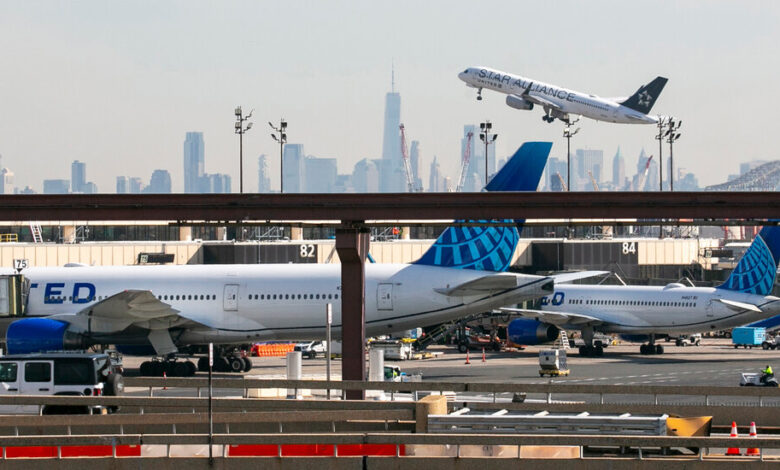New York Travel Disruptions Loom As Air Traffic Controllers Balk at Move

By late July, 17 air traffic controllers will be expected to trade in their headsets, walk out of their aging workplace on Long Island and report to a new office in Philadelphia, part of a plan to address a long-running problem with recruiting enough controllers to manage the skies around New York.
Despite the hefty incentives they have been offered to go along, the workers — unwilling to uproot themselves and their families — are balking at the move, and some powerful members of Congress are helping them fight back.
In a blistering letter sent to the Federal Aviation Administration last week, a group of New York lawmakers, including Senator Chuck Schumer, a Democrat and the majority leader, demanded that the agency abandon plans to force the employees’ relocation this summer.
The move places undue hardship on those workers, legislators argued. The “forced reassignments” by the F.A.A., Mr. Schumer and his colleagues wrote, are “both confusing and outrageous.” The controllers say their family lives would be disrupted, citing new marriages, disabled children and elderly parents they care for.
The fact that the Senate’s most powerful legislator would complain so loudly about a tiny group of workers underscores the power of the controllers’ nerve center in Westbury, N.Y. — an intense workplace whose formidable responsibilities, high-stress environment and strong personalities inspired a magazine story and the 1999 movie “Pushing Tin.”
The anger of the controllers and their supporters is clashing with the desperate effort by the F.A.A. to find and train enough employees willing to tackle the demands of ensuring the smooth and safe flow of aircraft in and out of the New York airspace — its most complex, by all accounts.
The New York hub has for years struggled with chronic vacancies, placing its recent staffing levels at some of the lowest levels in the nation. The F.A.A. hopes that shifting some of the responsibility for the work out of New York to a more affordable place to live will make it easier over time to recruit more controllers, leading to higher levels of staffing and, with that, increased air safety and efficiency.
But the agency’s plan also risks losing some of its more experienced controllers who are resistant to moving, which, perversely, could add to the staffing problems.
The relocations, which are scheduled for July 28, are necessary “to improve efficiency and ensure safety in this region,” Bridgett Frey, an F.A.A. spokeswoman, said in a statement.
The group targeted for the move handles the airspace around Newark Liberty International Airport, which in the view of the F.A.A. can be done just as well from Philadelphia as from Long Island. That is because this group of controllers uses radar scopes, instead of guiding planes from a runway tower overlooking takeoffs and landings.
F.A.A. figures show that staffing gaps last year at the Long Island building affected 4 percent of the 541,136 takeoffs and landings that occurred at New York’s major airports last summer. The agency expects the summer flying season, which begins later this month, to be its busiest since 2010.
The air traffic controllers say they, too, are fighting with safety in mind. They say they need to be in the same room with their New York colleagues, as they are now, to communicate quickly with them in a crisis.
“This is an extremely stressful job,” said Joe Segretto, the controller who is president of the local chapter of the National Air Traffic Controllers Association representing the New York airspace hub. For controllers, he added, being forced by the F.A.A. to relocate away from spouses and children “is going to add a tremendous amount of pressure.”
As moving day draws closer, the fight looms larger. The F.A.A. already put in place a 10 percent reduction in flight volume in the New York area to cope with lower staffing levels at its New York Terminal Radar Approach Control building in Westbury, known internally as N90. But any further staffing issues could mean there simply are not enough controllers to manage the increased volume planned for summer, forcing delays.
The fate of this handful of employees in a work force of more than 14,000 has gotten the attention of Transportation Secretary Pete Buttigieg, even as his workload strains under the demands of tackling jetliner assembly problems at Boeing, investigating the cause of recent train derailments and leading the battle against what the Biden Administration says are “junk fees” charged by airlines.
“The complexity of N90 is more complex than many countries’ entire airspaces,” Mr. Buttigieg said in an interview with The New York Times in December.
Given the low staffing levels at N90, he added, “we know there needs to be more attention there.” Just 59 percent of available controller roles in the building are filled, according to March figures from the F.A.A.
Last June, the F.A.A. was chastised by the Transportation Department, its parent agency, for doing too little to address yearslong shortfalls in controller staffing. Days after those findings were published, United Airlines delayed and canceled flights that affected 150,000 passengers. Scott Kirby, United’s chief executive, blamed the F.A.A. for controller shortages that he said exacerbated a situation in which his pilots were already contending with bad weather in the New York area.
Controllers working at N90, which is housed in a squat, windowless building in suburban Long Island, are responsible for overseeing the early ascent and descent of hundreds of thousands of flights at John F. Kennedy, LaGuardia and Newark airports each year — equating to at least 60 per hour in and out of Newark alone on a typical day or evening shift, according to F.A.A. data. N90 is second to Southern California’s airspace in size but is arguably a more critical cog in the overall system, affecting the punctuality and well-being of hundreds of thousands of passengers each day.
The F.A.A. has battled controller shortages nationwide since the pandemic, which forced pauses in training at both its Oklahoma City academy and on-site at air traffic control hubs around the United States. But N90’s low staffing has been particularly urgent.
The controllers’ jobs are so demanding and specialized that years of experience are customarily required to do them, including 18 to 24 months of hands-on training at N90 after working assignments at less-busy locations. Westbury’s short staffing in recent years has meant that some controllers have earned close to $400,000 a year because of extra pay, according to F.A.A. documents reviewed by The New York Times. At $183,000, the head of the F.A.A., Michael Whitaker, makes much less.
The agency over the years has tried a variety of strategies for filling the vacant jobs at N90, including offering raises and bonuses and using new recruitment tactics. (One hiring effort that targeted candidates with no relevant experience — referred to by some N90 controllers as “off-the-street” hires — was tried, controllers say, without much success.)
The washout rate has remained stubbornly high. Just 32 percent of N90 trainees achieved certification as fully qualified, according to F.A.A. statistics from March, a far lower rate than at comparable facilities. The Transportation Department’s report last year showed that N90 had the fewest supervisors of any Terminal Radar Approach Control, or Tracon, building in the nation, with only eight in place out of 30 authorized slots.
The F.A.A. has been working to relocate some of N90’s controllers to Philadelphia since at least 2020, only to be stymied by both the controllers’ union and New York legislators.
Its most recent effort to negotiate a move with the National Air Traffic Controllers Association began late last year. The two sides came to terms in March, according to documents reviewed by The Times, with a package that included an initial 15 percent incentive bonus and a $75,000 payout for those who moved to Philadelphia permanently. But, lacking an adequate number of volunteers to make the Philadelphia transfer work, the F.A.A. took a tougher stance about six weeks later, according to an April 29 memorandum that was reviewed by The Times: It notified more than a dozen N90 controllers that they would be involuntarily reassigned.
Under urging from the union, Representative Anthony D’Esposito, whose district includes N90, put together the May 7 letter demanding that the F.A.A. rescind its reassignments. In addition to Mr. Schumer, it was signed by Senator Kirsten Gillibrand and four other members of Congress from the region in and around Long Island. Three of them were Republicans, including Mr. D’Esposito.
“You have people who actually have strong, solid jobs, and they’re not moving because they want to — they’re moving because we’re telling them to,” Mr. D’Esposito said in an interview. “It’s not a good situation.”
Some controllers who do not move may be reassigned to new roles at N90. But getting a new role is dependent upon proving to the F.A.A. that a move would create undue hardship and would require training for a new post for a year or more.
The F.A.A., which spent $36 million to renovate and upgrade the Philadelphia Tracon building, has recently tried again to make the relocation attractive. In the April 29 memo in which it mandated the 17 staff moves, the agency raised to $100,000 its incentive bonuses for controllers who relocated to Philadelphia, either temporarily or permanently.
Yet Mr. Segretto, the union chapter president, and many of his members are unwavering.
“We are completely against it,” he said. “It’s forcing air traffic controllers to choose between their career and leave their families, or to resign from their job.”
Mark Walker contributed reporting from Washington.



